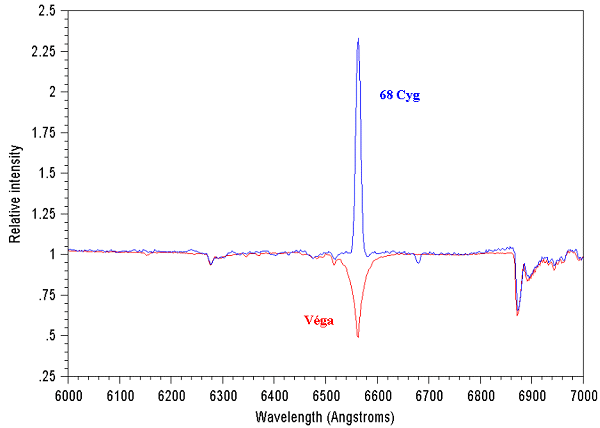Radiometric calibration consists in linking pixels intensities to a physical parameter. Its main goal is to allow comparisons of spectra from different origins and also measurements of important physical parameters. This operation is all-important since the flux distribution in the raw spectrum is very different from what has been emitted by the observed object. It shall be remembered that the optical signal went through several filters, namely that of the atmosphere, of the instrument, of the CCD's quantum efficiency...
The operations consists in the determination of the instrument's spectral response by comparison of the observed spectrum with a reference spectrum for the object under study. By dividing one spectrum by the other, a kind of "flat field" is obtained that can be used for radiometric scaling of the rest of the recorded data. The following figure shows several reference spectra for miscellaneous spectral types (from Pickles' atlas).

In the following image, a spectrum for Vega (that was not scaled radiometrically, but had to be scaled spectrally) was overlaid by an A0V star profile from the Pickles atlas. The Ha line is readily visible in either spectrum. It may be noticed that the telluric lines are still apparent in the reference spectrum (H20, around 7200A).

In order to achieve such scaling operations, specialized tools are needed. The VisualSpec program written by Valérie Desnoux is a good example of such tools.

Once the spectrum has been spectrally and radiometrically scaled, doing science becomes easy: here we compare the intensity of the Ha emission line for 68 Cyg with the same line in Vega's spectrum.

With help from reference stars whose spectral flux is know as absolute values, it is possible to scale other stars. Vega is one of those reference stars. The flux is usually expressed in erg/cm2/s/A.

Vega's spectrum, scaled to absolute values, expressed in erg/cm2/s/A.

In this further example, still for Vega, the flux corresponding to a black body @ 14000 K was substracted, and a slight polynomial correction supplied a flat continuum on the whole spectral domain. This operation eases photometric analyses and may even be compulsory in some situations.